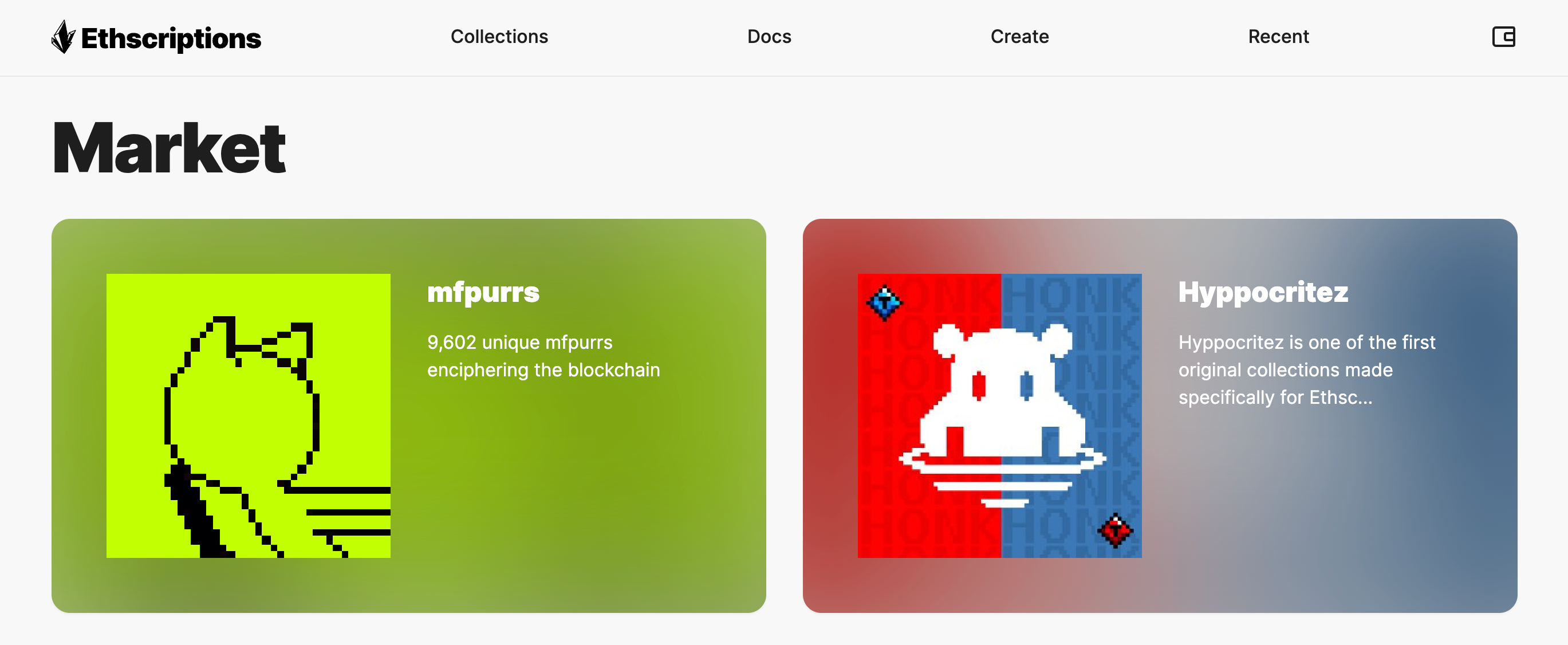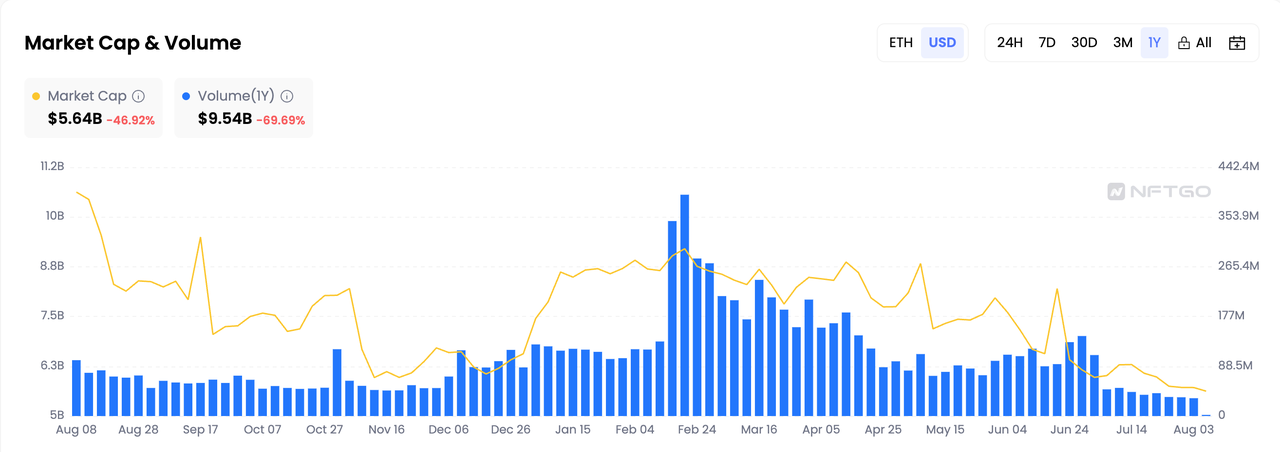With the development of the crypto market, the NFT track has gradually formed its unique market. However, under the continuous impact of the crypto bear market, the development of the NFT track this year is full of difficulties and challenges. According to NFTGO data, as of August 7, compared with last year, the total market value of NFT is approximately $5.64 billion, a decrease of more than 46.92% in the past year; the total transaction volume is $9.54 billion, a decline of more than 69.69%; and the number of traders exceeds 1.32 million, with a decrease of 27.86%. Therefore, from a data perspective, the market value of NFT is shrinking, and popularity and funds are constantly being lost.
Data source: NFTGO
Actually, despite the fact that NFT projects like Bored Ape Yacht Club (BAYC) and Cryptopunks have generated millions of dollars in transactions and once led to an NFT frenzy, controversies have been surrounding the development of the NFT track. For example, some people believe that since NFTs themselves have no inherent value, "value recognition" based NFTs are mostly hype; or, currently, the majority of NFTs are stored in centralized servers like AWS and do not truly exist on the blockchain. NFT holders may need to deal with sudden disconnections from project parties, unclear copyrights, and even the dilemma of having their NFTs stolen with no place to turn to for help. However, it cannot be denied that the development of any emerging field is not achieved overnight, and these doubts are precisely the driving force behind the continuous development and innovation of NFTs.
Going back to the beginning of this year, Casey Rodarmor released the Bitcoin Ordinals protocol. This protocol allows users to record different types of metadata (images, videos, PDFs, etc.) on satoshis, and it can directly create and store Bitcoin NFTs on the Bitcoin network, giving birth to the first Bitcoin network NFT. According to Dune data, the number of Inscriptions minted using Ordinals has exceeded 12 million in just six months.
With the rise of NFT storytelling, the Ethereum script protocol Ethscriptions has become popular in the cryptocurrency community. Below, we will introduce the advantages, challenges, and opportunities of its development starting from the operating process of Ethscriptions.
Introduction to Ethereum Script Ethscriptions
On June 17th, Ethscriptions, developed by Tom Lehman, co-founder and former CEO of Genius.com, was officially launched on the Ethereum network. It is a new protocol that uses transaction-call data to create and share digital collectibles on the Ethereum platform.
Ethscriptions Operating Process
Ethscriptions utilizes the Ethereum blockchain to store ownership information of each digital collectible. However, the file size should not exceed 96 KB, and currently, the protocol only supports images. Nevertheless, the creators of Ethscriptions have stated that they will support various types of files in the future.
Create a script
A successful transaction is made on the Ethereum network to create an Ethscription script when the input data is a valid data URI. In this process, Ethscriptions utilizes a feature called "Calldata," which is data stored in Ethereum smart contracts. This feature writes data in Ethereum's Calldata, which is cheaper and more decentralized compared to storing data in smart contracts.
URI refers to a Uniform Resource Identifier for different data. To ensure uniqueness and uniqueness, each URI is carefully designed and must meet the condition that there is no other Ethscription with the same content in the previous block or in earlier transactions within the same block. This clever approach ensures that no other Ethscription shares the same information.
When someone creates an Ethscription, they are considered the creator of that Ethscription. The person who receives the transaction is called the initial owner.
Transfer a script
The owner can also transfer their Ethscription to someone else. Find the ID of the Ethscription you want to transfer, which is the transaction hash of the created Ethscription. Write the Ethscription ID in the "Hexadecimal" field and send the transaction to the recipient. When this transaction is processed, the recipient becomes the new owner.
Tracking Inscriptions
Currently, users can view all created Ethscriptions on the website ethscriptions.com launched by Tom Lehman. The website also provides tools to create Ethscriptions on the Ethereum blockchain.
🔗https://ethscriptions.com/
Differences between Ethscriptions and Ordinals
The inscription models on Ethereum and Bitcoin ordinals are likely to bring new trends to the NFT field. The creators of Ethscriptions have claimed that they can be compared to Bitcoin's "Ordinals Inscriptions". The commonality between the two protocols lies in using Ethereum as a database, only writing the data that defines the assets on Ethereum, without using smart contracts for definition. The differences between the two are as follows:
Platform: Ethscriptions operate on the Ethereum network, while Bitcoin Ordinals operate within the Bitcoin ecosystem. This platform difference will subsequently affect various aspects of their functionality and characteristics.
Operation: Bitcoin Ordinals store smart contract transaction data on the Bitcoin network, while Ethscriptions utilize the Calldata feature to create inscriptions. Additionally, Ethscriptions require each image to be unique, meaning no two Ethscriptions can be the same. However, Bitcoin Ordinals allow the same image to be used on different tokens.
The supported data sizes and types are different. Currently, Ethscription supports data sizes limited to 96 KB or below, while Bitcoin Ordinals allows creators to form inscriptions of up to 4 megabytes. While Ordinals supports all types of digital files such as text, videos, music, or games, Ethscription only supports images. However, in the future, it plans to eventually add different file types.
Ethscriptions: Innovation or Regression?
An Overview of Ethscriptions Potential
Compared to traditional NFTs that rely on smart contracts, Ethscriptions is a new protocol that makes NFT assets more economical and decentralized. Since its emergence, Ethscriptions has gained popularity in the community due to its advantages:
Low user entry barrier. Users do not need extensive technical expertise to create and sell digital assets using the user-friendly interface. This provides clear instructions and guidance for beginners in the NFT world, creating a seamless user experience.
High transparency and security. The core of an NFT is a smart contract hosted on the ERC (Ethereum Request for Comment) chain. Most traditional NFT platforms only provide on-chain verification, while storing the NFT source content off-chain. In contrast, Ethscriptions stores data on a decentralized network and utilizes the Ethereum blockchain for transaction security and transparency. The ownership history of each NFT is traceable, preventing forgery or tampering while ensuring uniqueness.
Wide market access. Ethscriptions is backed by the leading Ethereum community and is highly accessible, open to anyone with internet connectivity. It allows artists, collectors, and enthusiasts to efficiently explore and participate in the world of NFTs. Currently, Ethscriptions has gained support from well-known NFT markets like OpenSea and Emblem Vault.
Challenges Faced by Ethscriptions
Although the Ethscriptions protocol has caused a sensation in the Ethereum community, with tens of thousands of images and inscriptions being carved onto the Ethereum blockchain in just a few hours, many community members believe that Ethscriptions is taking a step backwards.
For example, crypto KOL Chainleft believes that Ethscriptions is not innovative. Firstly, although this protocol was born as early as 2016 and people have been storing custom data or art in on-chain data for years, this technology has been around for years and is not groundbreaking, and it is not a good way to store data.
In addition, the liquidity mechanism of Ethscriptions is still imperfect. NFTs minted based on Ethscriptions currently need to be bundled into Ethereum's ERC-721 or ERC-1155 NFTs using tools similar to Emblem Vault, and then traded on Opensea. This trading method still relies on Ethereum's smart contracts and platforms like Opensea.
Finally, Ethscriptions needs improvement in terms of functionality and interaction. For example, the supported data size and types are currently limited, and these basic feature limitations prevent it from meeting the diverse needs of NFT minting. Additionally, what differentiates Ethscriptions is that it does not include any smart contract logic, making it more difficult to combine than traditional NFTs. How can NFTs generated by Ethscriptions interact with existing Ethereum smart contracts? Perhaps a series of new tools and platforms need to emerge for this.
Opportunities for Ethscriptions, driven by innovation
The future of Ethscriptions may bring further innovation and development to the Ethereum ecosystem. As the NFT space continues to evolve, Ethscriptions will continuously develop to meet the changing needs of users. A series of innovative tools and platforms and a variety of rich applications will continue to emerge. Here are some possible directions for the future development of Ethscriptions:
Enhanced features and functionalities. Ethscriptions may introduce new features and expanded functionalities to provide creators and users with more immersive and appealing experiences. This could include support for other file types, such as 3D models, augmented reality (AR) assets, and virtual reality (VR) experiences, thus opening up a world of possibilities for digital expression.
In addition, as the Ethereum network continues to evolve and expand, these advancements will enable Ethscriptions to handle larger volumes of transactions and provide a seamless user experience, while maintaining platform security and integrity.
Community-driven development. Due to its low barrier of entry, Ethscriptions can foster a vibrant community consisting of creators, collectors, and enthusiasts who actively contribute to the development and improvement of the platform, thereby cultivating a thriving ecosystem.
Integration of smart contract automation. Automated smart contracts can streamline transaction execution, reduce costs, and provide enhanced security and transparency, making Ethscriptions more efficient and user-friendly. Ethscriptions can integrate automated smart contract functionality to simplify the process of creating, selling, and transferring NFTs.
Expanded market and ecosystem. Ethereum is currently one of the leading public blockchain ecosystems, and with the strength of the Ethereum platform and the development of its ecosystem, there is potential for a dedicated platform for buying, selling, and trading Ethscriptions, as well as collaborations with other NFT markets and platforms to increase the exposure and accessibility of minted products.
Conclusion
In conclusion, as demonstrated by the aforementioned analysis, Ethscriptions on Ethereum provide a new form of asset for NFTs, offering developers and users a new choice in the realm of encrypted NFTs. Whether for project initiators, investors, developers, or users in the new field, incentivizing compatibility is the optimal choice for making projects better. Whether Ethscriptions will be a passing trend or a future trend, its development trajectory lies in the hands of every ecosystem developer, creator, and participant.
References:
https://docs.ordinals.com/
https://nftgo.io/analytics/market-overview
https://nftnow.com/guides/bitcoin-nfts-ordinals-inscriptions-explained-finding-buying-more/
https://crypto.news/ethscriptions-vs-ordinals-a-deep-dive-into-the-new-web3-phenomena/












